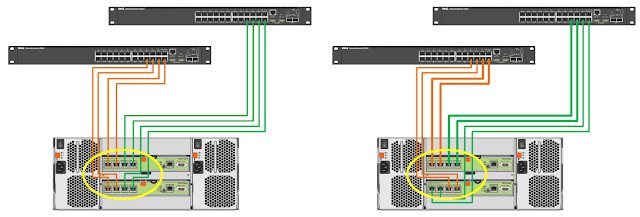Today I accidently stumbled upon something I didn’t know about the connectivity in the DELL Equallogic PSx1xx models (PS4100, PS4110, PS6100, PS6110). Let me start with the basics and work my way through to the interesting point.
EqualLogic controller basics:
Each DELL EqualLogic array member already has 2 controllers (you could buy a single controller version but why would you?). Each controller has off course CPU, RAM and Connectivity. The 2 controllers are in a Active-Standby mode. This means:
The CPU and RAM of both controllers is used but only the connections of the active controller.
Basically this means that at any given time the active controller (A) can fail and the only thing needed on controller B is activating the adjacent ports with the same IP addresses. EqualLogic also uses this procedure when upgrading firmware. First the firmware of the “standby” model is upgraded, then the connectivity is changed so Controller B becomes active and anfterwards controller A is upgraded too. The advantage here is that you only need 1 controller failover for a 2 controller upgrade.
Vertical NIC failover:
With the PSx1xx models DELL Equallogic took the failover level one step further. If a network port would fail, the adjecant port on the other controller would take over. As that controller is in “standby” mode this is not really an issue. This prevents a failover procedure, rebooting the controllers.
The Challenge:
Today I was designing the difference between a PS6100XV solution and a PS6110XV solution for a customer. Looking at the design I noticed a SPOF (Single Point of Failure): the switches! What happens if not the controller fails but the switch. In a normal configuration with a PS4100 or a PS6100 you would have 2x1GbE or 4x1Gbe per controller, equally devided between 2 switches. This would not give any issues. But on a 10GbE controller you only have 1x10GbE per controller, hence only 1 active connection.
AHA Erlebnis*:
If you look back at the PS6100 model you’ll find an opportunity here to go further than we went before on failover levels: crossconnect the vertical failover ports to different switches! This would always provide you with 4x1GbE connectivity even if one of the switches fails!



